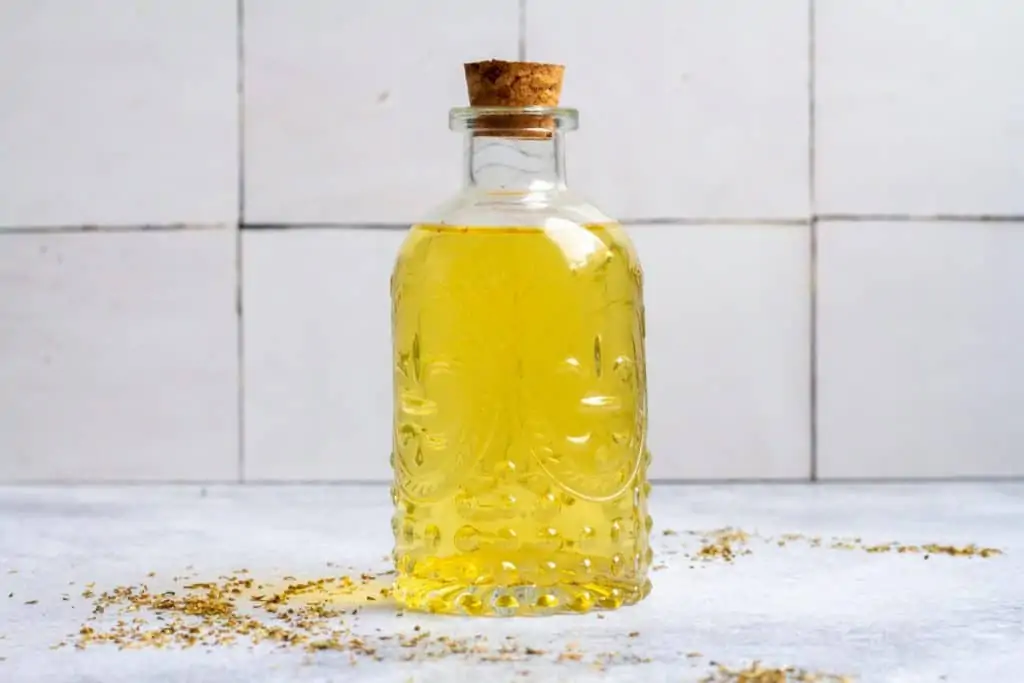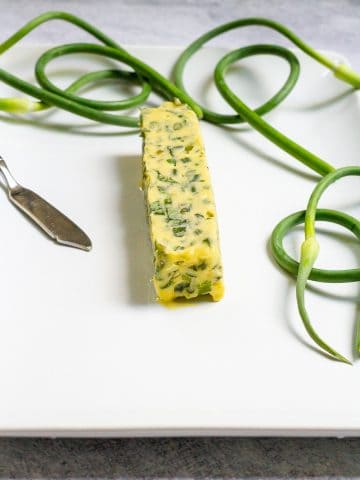This oregano vinegar is made with dried or fresh garden herbs, and is an herbal infused vinegar that's perfect for homemade vinaigrettes.

Spring is just around the corner!
If you're like me, it's possible that you've been trying to convince everyone that spring has been here for weeks.
Winter is so last year.
Spring means things come back to life!
The honeysuckle will bloom and I'll make honeysuckle syrup and honeysuckle vodka. My citronella plant can go back outside and I'll make another batch of citronella syrup.
Our chives are already peeking up from below the dirt, and soon I'll be preserving chives in chive butter and by making dried chives.
As spring gets closer and closer, I'm reminded that fresh herbs will be here soon. It's also a reminder to start using up some of my dried herbs!
One of my favorite ways to use herbs is to use them in a flavored vinegar.
This easy oregano vinegar is made with fresh or dried oregano and wine or champagne vinegar, and is perfect in homemade vinaigrettes.
Looking for more of our favorite garden to table recipes? Try making homemade hot sauce, hot pepper vinegar, crabapple butter and homemade mint tea!
Should I Use Dried or Fresh Oregano?
Use either!
The recipe card below lists directions for both.
If using dried oregano, make sure the dried herbs still have a strong scent. If they don't smell like oregano, your vinegar won't taste like oregano.
I'm using dried oregano in the photos because it's currently too early in the year to harvest fresh oregano.
Can I Use Oregano Flowers?
Yes, absolutely!
If your fresh oregano begins flowering, pick the flowers to keep your plant from going to seed.
After picking, you don't have to toss the flowers into your compost pile, because the flowers are also edible and will add delicate floral notes to the vinegar.

This Recipe Uses Warm Vinegar. Why Not a Cold Infusion Instead?
There are two ways to infuse herb vinegar.
You can add the vinegar and herbs to a jar and infuse the vinegar for weeks, or you can add warm vinegar to the herbs and infuse it for a shorter period of time.
When infusing delicate herbs, like in this chive blossom vinegar or this basil vinegar, I typically prefer a cold infusion. Even when I use a warm vinegar infusion technique with delicate herbs, I'll generally continue to steep the herbs for at least a week or two.
That said, oregano has a much stronger flavor than either chive blossoms or basil.
So yes, you can do a longer infusion with this vinegar if you prefer, but I prefer a warm infusion and a quick ten-minute steep when making oregano vinegar.
Check the recipe card notes for cold infusion directions.
What Kind of Vinegar Should I Use?
I recommend using either white wine vinegar or champagne vinegar. Both have mild flavors (for vinegar!) and will allow you to clearly taste the oregano.
Apple cider vinegar will also work, but it's got a much stronger flavor that might slightly mask the herb flavor.
Rice vinegar or homemade fruit vinegar will also work well, but take care if you opt to do the alternate cold infusion method with fresh oregano. These are both (typically) low acidity vinegars, and fresh herbs will lower the acidity level even more, so it's best to do a cold infusion in the fridge to keep things safe.
I do not recommend using white distilled vinegar. The flavor is quite astringent and it's better used for cleaning.
How to Make Oregano Vinegar
Warm vinegar in a small pot. Turn off the heat before it comes to a boil.
Add the herbs and steep for 10 minutes.

Finally, strain out the herbs and bottle the vinegar.
Store it in the fridge and use it in your favorite vinaigrettes!

Oregano Vinegar
Ingredients
- 1 tablespoon dried oregano or ½ cup fresh oregano and/or oregano blossoms Make sure the dried herbs are fragrant before using.
- 1 cup white wine vinegar OR champagne vinegar
Instructions
- If using oregano blossoms: Clean the flowers by dipping them into a bowl of water, and set aside to dry.If using fresh oregano: Rinse the oregano and set aside to dry.Heat the vinegar until it's warm. Do not bring it to a boil. Turn off the heat.For dried oregano: Stir the oregano into the vinegar.For fresh oregano: Add the oregano to a clean glass jar, and muddle with a cocktail muddler or the back of a wooden spoon. Pour the vinegar over the flowers into the jar until the jar is almost full. (The amount of vinegar listed is approximate; you may need slightly more or less.)

- Allow the herbs to steep covered for at least 10 minutes. Strain out and discard (or compost) the oregano. Store at room temperature for up to 3 months or in the fridge for 6-8 months.

Notes
- If you prefer, you can skip heating the vinegar and do a longer cold-infusion.
- Add the oregano and vinegar to a clean glass jar. If using fresh oregano, top with a clean citrus peel to hold the herbs below the liquid.
- Store for 1-5 weeks out of direct sunlight, or until you like the flavor.
- I recommend using white wine or champagne vinegar.
- If all you have on hand is apple cider vinegar, it will work, but the flavor of the oregano will be less distinctive (because ACV has a strong flavor).
- If you use rice vinegar or homemade fruit vinegar, the cold-infusion method listed above is not safe to do at room temperature (if using fresh oregano), because rice vinegar is less acidic than other vinegars. (The fresh herbs further lower the acidity level. Commercially dried herbs should work just fine.)
- Avoid using white distilled vinegar, because it's too astringent-tasting.







Leave a Comment: